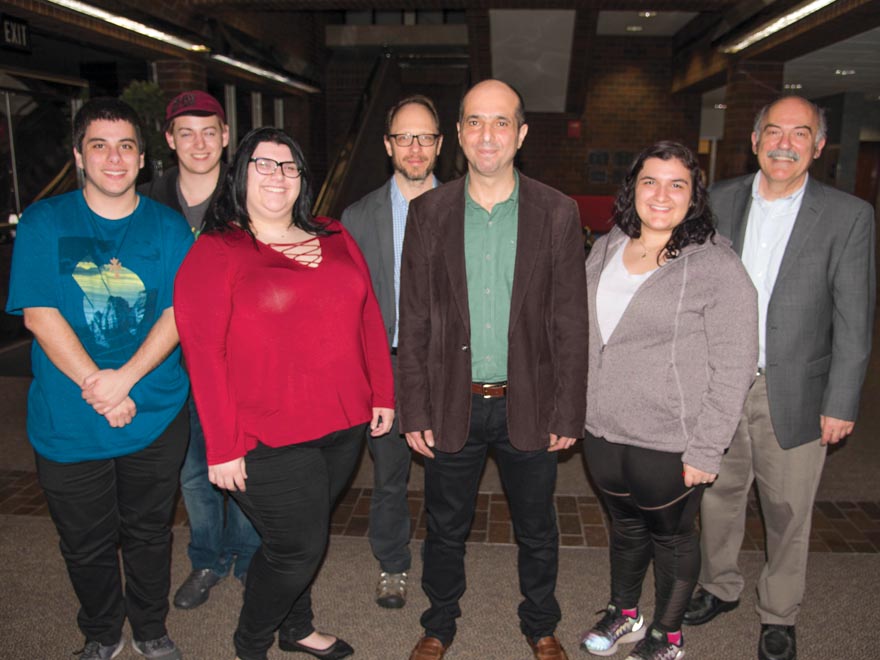
Photo: Hourig Attarian
Michael Rettig
Editor
Armenians uniquely remem-ber the region of Van/Vaspurakan in a way that Turks and Kurds do not. Kazan Visiting Professor in Armenian Studies Dr. Yektan Türkyılmaz first made this realization during his travels in Armenia, where he noticed that the name of Van permeated the country from printing houses and football teams, to radio stations and more. “It was my first realization that the memory of Van haunted Armenians, while it has never been the focus of Turkish or Kurdish narratives,” explained Dr. Türkyılmaz. “The volume of Armenian literature on Van surpasses that of other peoples.”
Dr. Türkyılmaz realized that studying the social political nexus of Van would be a “challenging but promising endeavor.” On February 6, Dr. Türkyılmaz presented on “Van/Vaspurakan Armenians: from Renaissance to Resistance and Genocide” as a part of the Spring Lecture Series.
Dr. Türkyılmaz noted that the Vaspurakan region transcended national boundaries by straddling the Ottoman, Russian, and Persian empires, thus facilitating a flow of people and information between the three empires. Van attracted Armenian intellectuals and re-volutionaries from Russia and Iran, while foreign missionaries and consuls helped connect Van to Europe and America. The region became economically prosperous in the 19th century due to the leather and furniture industries and a new class of Van elites emerged with Western tastes and intellectual backgrounds.
Van became a notable center for Zartonk, or the Armenian enlightenment. Dr. Türkyılmaz stressed that Van was not merely a recipient of new ideas from Constantinople, Europe, or Tiflis, but that it was “a place that inspired other Armenian cultural locations with new ideas.” He explained that it was Van’s intellectual life and political climate that helped redefine “Armenianness” into a national identity. Van intellectuals, such as Khrimian Hayrik, advocated for the creation of a unified vernacular based on classical Armenian enriched by local dialects. They sought to modernize the language by “turning to the countryside” rather than Western dictionaries.
According to Dr. Türkyılmaz, Van is also noteworthy because the Armenian citizens were not “docile victims, but victims who rejected victimhood.” He argued that historians should reevaluate the history of Vaspurakan to recognize that Armenians were always active agents, “as rebellious clerics, intellectuals, educators, bourgeois politicians, revolutionary fighters, and corrupt officials” and not merely victims. In 1885, Armenian revolutionaries in Van founded the Armenakan party, a nationalist liberal group that advocated for an armed struggle for national liberation.
Dr. Türkyılmaz explained that it was because of the organized efforts of the Armenakan party that Van was one of the few sites of successful resistance against Turkish massacres in 1896.
However, Armenians were deeply divided in 1915. The Dashnak (Armenian Revolutionary Federation) party had allied with the Committee of Union and Progress (CUP) in the Revolution of 1908. While this cooperation quickly disintegrated throughout much of the Ottoman Empire, negotiations between the parties remained strong in Van up to the eve of the genocide. The CUP did not have strong Muslim backing in Van, so they relied on the Dashnaks to combat potential Kurdish threats. According to Dr. Türkyılmaz, the Armenian political leadership remained confident of their power in Van despite rumors of threats against Armenians.
Dr. Türkyılmaz called Van the “epicenter of the genocide” because it was where genocidal intent first materialized among the CUP leaders. The Armenians successfully defended Van during the Genocide and formed a short-lived government.
Dr. Türkyılmaz noted that Van was the first Armenian nation-state experience and that many of its leaders later took important posts in the Armenian Republic in 1918.
However, the Armenians were forced to evacuate Van with the Russian army at the end of July 1915, during which thousands of Armenians died.
“The Genocide left behind only losers on all sides, and a dead historic city; a city of enviable beauties, a city of kings and gods, a city of orchards and water springs, a city of a thousand years of labor, a city of a millennia of coexistence that endured Mongolian invasion, that endured the massive earthquake of 1648, that endured the great fire of 1876, that endured the famine of the 1880s, that endured the Hamidian massacres, but could not endure the man-made disaster of the Genocide.” Dr. Türkyılmaz explained.
“That glorious Van has died, only to be revived in the imaginations of the people longing from afar.”
 Hye Sharzhoom Armenian Action
Hye Sharzhoom Armenian Action